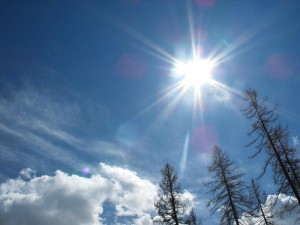The healing power of sunlight by Joel Le Blanc
 Humans have worshipped the sun since the dawn of civilisation. Egyptians honored the sun as a deity as far back as 14th century BC, and Ancient Greeks believed that the sun was a god, or the chariot of a god, who was both a patron of light, medicine and prophecy.While this particular form of religious belief is no longer current, scientists maintain that the sun is a vital part of human health and well-being. According to a study published in 2009, mortality in New Zealand is at it’s lowest in February.
Humans have worshipped the sun since the dawn of civilisation. Egyptians honored the sun as a deity as far back as 14th century BC, and Ancient Greeks believed that the sun was a god, or the chariot of a god, who was both a patron of light, medicine and prophecy.While this particular form of religious belief is no longer current, scientists maintain that the sun is a vital part of human health and well-being. According to a study published in 2009, mortality in New Zealand is at it’s lowest in February.
There are many factors that come into play with this statistic, and one theory is that February is one of the brightest and warmest months of the year — a time when Kiwis get a fair amount of sun exposure. While invisible ultra-violet (UV) rays found in sunlight have received very poor press in recent generations, it’s vital to remember that too little sunlight is almost as dangerous as too much.
Most people are aware that sunlight is a primary source of vitamin D (a nutrient required for bone strength, immune function, mood balance, and prevention of breast, colon and prostate cancer). But I wonder how many people know that sunlight exposure also improves your sleep quality, reduces depression, protects against auto-immune condition and protects the brain from aging?
Sunlight has a harmonizing effect on the brain. When we take off our glasses during the day and allow our eyes to be exposed to natural light, it signals the pineal gland in the brain to balance sleep hormone levels and adjust the body clock.
According to the Journal of the American Medical Association, this effect reduces depression, improves memory, balances sleep and has a positive effect on quality of life in elderly Alzheimer’s patients. At least one study has also confirmed that frequent sunlight exposure in children helps to protect against multiple sclerosis (MS) later on in life.
Up to five percent of the population suffer from seasonal affective disorder (SAD) in the winter months — a condition where low moods and depression are triggered by not receiving enough UV light. This is particularly true for residents living in cities, such as Dunedin, that receive less light throughout the year.
It becomes important during the darker months when the winter blues begin to set in, to get outside and let your skin be exposed to the morning or late afternoon sun for fifteen minutes. One study has found that people who work outside during the Winter are least at risk of being affected by SAD.
Always use sunscreen when going outside in the midday or early afternoon sun during the warmer months of the year. If you have pale skin or burn easily, you have to be extra careful. Pale skin types are the most sensitive to skin cancers.
No one wants to put themselves at risk when going outside, as skin cancer is a serious health problem for many New Zealanders. But even a few extra minutes in the morning sun every day can make a dramatic difference to the quality of your health and your life. Sunlight is a vital aspect of human existence, and no pill, supplement or health food can ever replace it.
Joel Le Blanc
Joel Le Blanc is a freelance writer, poet and medical herbalist. He has published articles on health, alternative medicine, literature, art and food, and is currently completing a BA in English and Creative Writing at the University of Canterbury. Joel runs a blog for creative people wanting to learn more about natural and alternative medicine at The Wormwood Files.
loading...
loading...

What a pleasure to read such UNIVERSAL good common sense and logic re the SUN. To the Maya “Father Sun” is the ‘right eye of God’ and is presented by the colour RED. So one could say wearing Red is a warm experience.
Has always made sense to me that the Sun is our friend. We’d all be dead with ‘Him’ and easy to see why/how we are energized by the feel of Him on our skin. [yes yes in the mornings for a Sun’Bath’ is best as this article explains….
Great reading, thanks
loading...
loading...
p.s. of course first comment could read ……………”We’d all be dead withOUT ‘Him’ and easy
…..
loading...
loading...